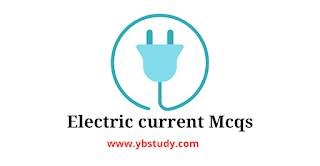Electric current class 10 MCQ Pdf
Electric Current class 10 MCQs:
Electric current MCQ is important for class 10 students appearing for Maharashtra board, CBSE board exam as well as NEET Aspirants also. Below we are provided MCQ on Electric current Prepared by subject experts and students can refer to these Electric Current MCQ Questions for their exam preparation. Below MCQ questions and answers are prepared for class 10 and class 10 students.
MCQ on Electric Current:
1. The unit of potential difference is________
A) Volt
B) Ohm
C) Ampere
D) Faraday
Answer: A
2. A fuse wire is inserted in which wire?
A) Live wire
B) In the neutral wire
C) In the earth wire
D) May be connected in any line
Answer: A
3. The rate of flow of an electric charge is known as______________
A) Electric potential
B) Electric conductance
C) Electric current
D) None of these
Answer: C
4. To get 2 Ω resistance using only 6 Ω resistors, the number of them required is____________
A) 2
B) 3
C) 4
D) 6
Answer: B
5. Two devices are connected between two points say A and B in parallel. The physical quantity that will remain the same between the two points is________
A) current
B) voltage
C) resistance
D) None of these
Answer: B
7. A fuse wire repeatedly gets burnt when used with a good heater. It is advised to use a fuse wire of_________
A) more length
B) less radius
C) less length
D) more radius
Answer: D
8. What is the relationship between resistance and current?
A) They are directly related to each other.
B) They are inversely related to each other.
C) The resistance has a greater magnitude than the current.
D) The current has a greater magnitude than the resistance
Answer: B
9. Which of the given is the SI Unit of Electric Current?
A) Ohm
B) Ampere
C) Volt
D) Faraday
Answer: B
10. The relation between the potential difference (V) and current (I) is___________
A) V α I2
B) V α 1/I
C) V2 α I
D) V α I
Answer: D
11. The resistance of a conductor is directly proportional to_________________
A) Its area of cross-section
B) density
C) melting point
D) length
Answer: A
12.The purpose of a rheostat is___________
A) Increase the magnitude of current only
B) Decrease the magnitude of the currently only
C) Increase or decrease the magnitude of current
D) None of these
Answer: C
13. Point to be kept in mind for verification of Ohm’s Law is______________
A) Ammeter and voltmeter should be connected in series
B) Ammeter should be connected in series and the voltmeter in parallel
C) Ammeter should be connected in parallel and the voltmeter in series
D) Ammeter and voltmeter should be connected in parallel
Answer: B
14. The north pole of Earth’s magnet is in the____________
A) Geographical South
B) Geographical East
C) Geographical West
D) Geographical North
Answer: A
15. An electric motor is a device which transforms______________
A) Mechanical energy into electrical energy
B) Electrical energy into mechanical energy
C) Kinetic energy into potential energy
D) Electrical energy into Potential energy
Answer: B
16. The frequency of electricity produced by the DC generator is equal to_______________
A) 0 Hz
B) 50 Hz
C) 100 Hz
D) 200 Hz
Answer: A
17. The force exerted on a current-carrying wire placed in a magnetic field is zero when the angle between the wire and the direction of the magnetic field is________________
A) 45o
B) 60o
C) 90o
D) 180o
Answer: D
18. How can the electric charge be established?
A) Electrons can be removed from atoms and accumulated to produce a negative charge.
B) Atoms from which electrons have been removed produce a positive electric charge.
C) Both A and B.
D) Neither A nor B.
Answer: C
19. Voltage is a form of________________
A) Kinetic energy
B) Potential energy
C) both Potential and Kinetic energy
D) None of the above
Answer: B
20. The curve representing Ohms law is a____________
A) Linear
B) cosine function
C) Parabola
D) Hyperbola
Answer: A
21. To produce an electric current what is the requirement?
A) A voltage source
B) A source of energy that moves charges
C) An electric field moving through a conductor
D) All
Answer: D
22. The current which is assumed to be flowing in a circuit from a positive terminal to a negative, is called______________
A) direct current
B) pulsating current
C) conventional current
D) alternating current
Answer: C
23. When no current is passed through a conductor__________
A) the free electrons do not move
B) the average speed of a free electron over a large period is not zero
C) the average velocity of a free electron over a large period is zero
D) the average of the velocities of all the free electrons at an instant is non zero
Answer: D
24. Drift velocity of electrons is due to_____________
A) motion of conduction electrons due to random collisions.
B) motion of conduction electrons due to electric field E
C) repulsion to the conduction electrons due to the inner electrons of ions.
D) collision of conduction electrons with each other.
Answer: B
25. In the absence of an electric field, the mean velocity of free electrons in a conductor at absolute temperature (T) is______________
A) zero
B) independent of T
C) proportional to T
D) proportional to T2
Answer: A

